![]()
![]()
![]()
Use LEFT and RIGHT arrow keys to navigate between flashcards;
Use UP and DOWN arrow keys to flip the card;
H to show hint;
A reads text to speech;
56 Cards in this Set
- Front
- Back
|
What is the membrane found around cells called? |
plasma membrane |
|
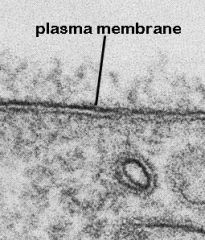
What is the plasma membrane made up of? |
Proteins and phospholipids bilayer |
|
|
true or false, the plasma membrane is a partially permeable barrier? |
true |
|
|
What could you see under an electron microscope (TEM)? |
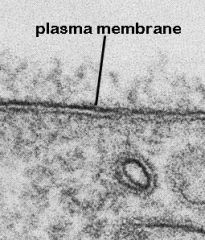
Two dark bands the distance across the membrane would be about 7nm |
|
|
Who proposed the fluid mosaic model of membranes? |
Singer and Nicholson |
|
|
Why are membranes described as being arranged in a fluid mosaic way/ |
Fluid: Phospholipids and proteins move around each other Mosaic: describes the pattern of the arrangement of proteins within the phospholipid bilayer. |
|
|
What are the five main components of the plasma membrane? |
phospholipids cholesterol glycolipids proteins glycoproteins |
|
|
What is the role of phospholipids |
Act as a barrier to water soluble/polar molecules allow lipid soluble, small non polar substnaces to diffuse across. Allow cells to maintain concentration gradients on either cells. |
|
|
How are phospholipids arranged? |
bilayer, hydrophobic tails face inwards, hydrophilic heads face outwards. |
|
|
Which type of cells is cholesterol found in? |
eukaryotic cells |
|
|
Why is cholesterol part of the plasma membrane? |
SAtbility and fluidity. It is a steroid molecule that fits between the fatty acid tails, completing the membrnae barrier to water and ions. It binds to the hydrophobic tails of phospholipids, causing them to pack more closely together. |
|
|
What is the structure of a glycolipid? |
phospholipids with carbohydrates attached. |
|
|
What are glycolipids there for? |
receptors for cell signalling and recognition |
|
|
What is the difference between intrinsic and extrinsic proteins? |
Extrinsic span half the bilayer and are there for cell signalling and recognition, to act as receptors as well as enzymes. Intrinsic proteins span across the whole bilayer and are channel or carrier proteins. They allowthe transport of polar molecules. |
|
|
True or false glucose is a polar molecule? |
true |
|
|
What are glycoproteins? |
Proteins with carbohydrate attached. |
|
|
What is the role of glycoproteins? |
Receptors for signalling molecules e.g. hormones. Cell signalling and recoginitions e.g. cell surface antigens. Binding cells together to the basemembrane making tissues, cell adhesion |
|
|
Why is it important for cell adhesion or binding to basement membrane (role of glycoproteins)? |
makes tissues |
|
|
Which enzyme in respiration is a extrinsic protein? |
atp synthase |
|
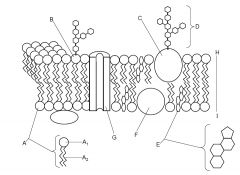
What does D show? |
Carbohydrate component of glycoprotein |
|

What is E? |
Phospholipid |
|
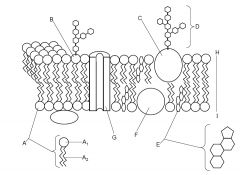
What is G? |
channel protein |
|
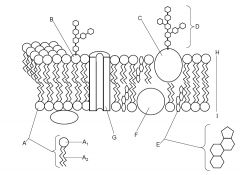
What is A? |
phospholipid |
|
|
What is the role of membrane within cells? |
Compartmentalisation- separate cell components from cytoplasm Holding the compents of metabolic pathways e.g. mitochondria regulating transport of material into and out of mitochondria. |
|
|
What is the role of membranes at the surface of cells? |
separate cell contents from outside environment cell recognition and signalling regulating transport materials into or out of cells. |
|
|
How do temperatures below 0C affect the plasma membrane? |
Increases permeability because although The phospholipids don't have much energy so they can't move very much and are packed close together. Proteins denature increasing the permeability of the membrane. Ice crystals may form and pierce the membrane making it highly permeable when it thaws. |
|
|
How does permeability change as temperature increases between 0-45C? |
As the temperature increases the phospholipids can move more because they have more kinetic energy, increasing the permeability of the membrane. |
|
|
What happens to the plasma membrane at temperatures above 45C? |
The phospholipid bilayer starts to break down (melt) and the membrane becomes more permeable. Water inside the cell expands putting pressure on the membrane. Channel and carrier proteins in the membrane denature so they can't control what enters or leaves the cell. Permeability increases |
|
|
What is diffusion? |
Movement of substances from an area of high concentration to an area of low concentration down a concentration gradient across the membrane via the phospholipid bilayer. |
|
|
What is required for diffusion to occur? |
concentration gradient, molecules must have kinetic energy. |
|
|
What molecules can diffuse through the bilayer? |
Lipid soluble e.g. steroid hormones small e.g. CO2 O2 Small and polar e.g. H2O |
|
|
What factors affect rate of diffusion? |
Temperature concentration gradient thickness of exchange surface surface area |
|
|
What is facilitated diffusion? |
The movement of substances from a high concentration to a low concentration, down a concentration gradient across the membrane via carrier or channel proteins. |
|
|
What is required for facilitated diffusion to occur? |
Concentration gradient, molecules have to have kinetic energy, carrier/channel proteins present. |
|
|
True or false ATP is required for facilitated diffusion and simple diffusion? |
false. |
|
|
What is facilitated diffusion limited by? |
temperature, concentration gradient, number of carrier/channel proteins in the membrane. |
|
|
What do channel proteins do? |
Act as pores allowing only specific ions through. They can be gated. |
|
|
What do carrier proteins do? |
Only allow specific large molecules to pass through. When a molecule e.g. glucose binds, it changes shape and transfers the molecule to the other side of the membrane. |
|
|
How do different cells allow exit and entry of different substances? |
Different membranes have different proteins in their bilayer |
|
|
What is osmosis? |
Movement of water from an area of high water potential to an area of low water potential down a water potential gradient across phospholipid bilayer or via aquaporins. |
|
|
What are aquaporins |
Protein channels which allow passage of water through plasma membrane. |
|
|
What is water potentials measured in? |
KPa |
|
|
What is the highest water potential possible? |
0kPa (pure water with no solutes) Solutes lower the water potential. |
|
|
What are hypertonic solutions? |
Have a lower water potential than cell causing water to move out of cell. |
|
|
What are isotonic solutions? |
Same water potential as the cell, there is no net movement of water molecules. |
|
|
What are hypotonic solutions? |
Has a higher water potential than that of cell, water moves into the cell. |
|
|
What happens to palnt cells in hypotonic solution? |
becomes turgid: call wall prevents from bursting. Cell membrane pushes against the cell wall, increase in oermanent vacuole. |
|
|
What happens to aniaml cells in hypotonic solutions? |
Burst open- haemolysed |
|
|
What happens to animal cells in hypertonic solutions? |
crenate (shrink) |
|
|
What happens to plant cells in hypertonic solutions? |
Phosmolysed as the plant cell membrane pulls away from cell wall. |
|
|
What is active transport? |
The movement of large or water soluble substances across the mebrane via carrier proteins. It does not require a concentration gradient, however ATP is required. |
|
|
Why do molecules require kinetic energy for active transport? |
to bind to carrier proteins. |
|
|
How do carrier proteins move substances? |
AT changes the shape of the cariier proteins. (this ensures one way flow) |
|
|
What molecules are actively transported? |
non-lipid soluble, large and polar |
|
|
How can the movement of molecules by active transport be stopped? |
Inhibiting ATp |
|
|
How are epithelial cells lining the ileum adapted for increased absorption? |
Microvilli-finger like projections that increase the surface area. Increased number of protein channels and carrier molecules in their membrane. |

